Powerfix QA 271 Handleiding
Powerfix
Niet gecategoriseerd
QA 271
Bekijk gratis de handleiding van Powerfix QA 271 (4 pagina’s), behorend tot de categorie Niet gecategoriseerd. Deze gids werd als nuttig beoordeeld door 51 mensen en kreeg gemiddeld 4.5 sterren uit 26 reviews. Heb je een vraag over Powerfix QA 271 of wil je andere gebruikers van dit product iets vragen? Stel een vraag
Pagina 1/4

8
B
P1
B
C
D
E
V1
Fabricant / service
Smartmaxx GmbH
Inselstraße 27
D-04103 Leipzig
Assistance : +49 (0) 341 99 99 43 79
E-mail : office@smartmaxx.info
IAN 43011
Veuillez conserver le ticket de caisse et la référence de l’arti-
cle (par ex. IAN12345) à titre de preuves d’achat pour
toute demande.
FRFR FR FR FR FR FR FR
Monter le cadre sans mécanisme
d‘autofermeture
Pour cette variante, aucun ressort de fermeture K n‘est
nécessaire.
Étape 1
Sectionnez les pointes des parties inférieures de charnière
I jusqu’à l’extrémité de l’encoche (voir fig. 17).
Avis : Ne sectionnez en aucun cas la totalité de la baguette.
La charnière deviendrait alors inutilisable.
Étape 2
Emboîtez les parties inférieures de charnière I dans les par-
ties supérieures de charnière H. Suivez les étapes de travail
3 à 6 du chapitre « Montage du cadre avec le mécanisme
de fermeture automatique » (sans utilisation des ressorts K).
Nettoyage et entretien
N’utiliser en aucun cas un produit nettoyant corrosif ou
abrasif.
Nettoyez le cadre à l’aide d’un chiffon ne peluchant pas,
légèrement humidifié.
Utilisez le cas échéant un produit nettoyant doux.
Mise au rebut
L’emballage et le matériel d’emballage se com-
posent exclusivement de matières recyclables.
Éliminez-les dans les collecteurs de recyclage
locaux.
Les possibilités de recyclage des produits usés sont à deman-
der auprès de votre municipalité
Vidéo de montage
www.smartmaxx.info
Veillez à ce qu’il y ait un écart d’au moins 15 cm entre le bord
supérieur et le bord inférieur du cadre et la partie supérieure
de la charnière H. Percez les trous à vis avec un foret de
2,0 mm (voir fig. 12).
Étape 2
Fixez les parties supérieures des charnières H avec les vis
Q, pour commencer à travers le trou inférieur du profilé en
aluminium B du cadre de la moustiquaire. Faites glisser
ensuite les ressorts K dans la partie supérieure de la char-
nière H et fixez-les avec les vis Q à travers le trou supérieur
(voir fig. 12).
Étape 3
Posez la porte moustiquaire contre votre encadrement de
porte. Le cas échéant, faites-vous aider par une deuxième
personne pour cette opération. Orientez la face de la porte
moustiquaire sur laquelle sont montés les aimants N (côté
poignée) sur votre encadrement de porte de telle sorte qu’env.
2,5 cm du profilé longitudinal B de la porte moustiquaire
reposent contre l’encadrement de la porte. Ceci vous permet
d‘exploiter la puissance de fermeture optimale des aimants
N (voir fig. 13).
Étape 4
Placez alors les parties inférieures de charnière I dans les
parties supérieures de charnière H en les faisant passer
au-dessus des ressorts K. Maintenez les parties inférieures
de charnière I contre l’encadrement de la porte et marquez
les trous 2 et 4 (voir fig. 14).
Étape 5
Percez les trous avec un foret de 2,0 mm et vissez les parties
inférieures de charnière I à l‘encadrement de porte à l‘aide
de deux vis à tête fraisée Q pour chacune. Fixez les ressort
K en enfichant les capuchons de charnière J sur les par-
ties inférieures des charnières I (voir fig. 15).
Étape 6
Fixez les plaques de fermeture L à l’encadrement de la porte
à la hauteur des aimants N à l’aide de deux vis à tête fraisée
M pour chacune (voir fig. 16).
Attention : L‘extrémité prépercée doit se trouver du côté de
l‘aimant (fig. 8).
Étape 10
Terminez maintenant le cadre en encliquetant le second profilé
en aluminium B sur les extrémités libres du profilé en alumi-
nium C, du croisillon médian D et vissez-le avec la tôle de
protection en aluminium E à l‘aide des vis Torx P1 . Pour
enfoncer l‘équerre A, utilisez si nécessaire un marteau en
caoutchouc (voir fig. 8).
Étape 11
Coupez les longues baguettes à encliqueter G1 en quatre
parties adaptées aux parties supérieure et inférieure des pro-
filés en aluminium B. Raccourcissez les quatre baguettes à
encliqueter G2 à la largeur mesurée (I) moins 2 cm (voir fig. 9).
Étape 12
Posez le tissu en fibres de verre S sur le cadre. Commencez
par tendre la moitié supérieure du cadre à moustiquaire.
Commencez pour cela sur le bord supérieur gauche ou droit
pour fixer le tissu en fibre de verre S avec une baguette G
dans le profilé en aluminium C. Poursuivez cette opération
avec les baguettes à encliqueter G sur le croisillon médian
D. Fixez maintenant avec les baguettes G le tissu en fibre
de verre S dans la moitié supérieure du cadre à gauche et
à droite dans les profilés en aluminium B (voir fig. 10).
Étape 13
Découpez le tissu en fibre de verre S sur la baguette à
encliquetter G du croisillon médian D. Retirez le reste de
tissu supérieur avec un cutter à moquette (voir fig. 10). Prenez
le tissu restant en fibres de verre S et procédez avec la moi-
tié inférieure du cadre de moustiquaire comme pour la moitié
supérieure de l‘étape 12 (voir fig. 10).
Étape 14
Enfichez la poignée extérieure U1 avec le canal à vis à travers
le trou prépercé du croisillon médian D et fixez-le en vissant
la poignée intérieure U2 par l‘arrière (voir fig. 11).
Monter le cadre avec mécanisme
d‘autofermeture
Étape 1
Répartissez de manière symétrique les parties supérieures de
la charnière H sur le profilé B en face du côté poignée.
pour enfoncer l‘équerre T1 et T2. Glissez le joint à brosse F2
par le haut dans le profilé en aluminium B dans la rainure
prévue à cet effet jusqu‘en bas dans l‘équerre déjà installée
T1 et T2 . Laissez 3cm dépasser au niveau de l‘extrémité
supérieure et coupez le joint à brosse F2 (Voir fig. détaillée 4).
Procédez de la même manière avec le second profilé en alu-
minium B.
Étape 5
Vissez un profilé en aluminium B avec la tôle de protection
en aluminium E en utilisant les vis torx P1 et l‘embout torx
P2 (voir fig. 5). Poussez le joint à brosse F2 dans la rainure
prévue à cet effet dans la tôle de protection en aluminium E
jusqu‘à l‘équerre T1 ou T2 et continuez jusqu‘à la dépasser
d‘env. 3 cm. Poussez le joint à brosse F1 dans la rainure pré-
vue à cet effet au niveau de la surface inférieure de la tôle de
protection E et coupez celle-ci avec une saillie d‘env. 3 cm
(fig. 5).
Étape 6
Faites glisser par profilé en aluminium B un connecteur à
croisillon médian V1 en haut dans la fente prévue à cet effet
(voir fig. 6 / a). Insérez l‘équerre A avec le joint à brosse
supérieur en haut dans les profilés en aluminium B. Placez
les deux aimants N dans l’équerre A située du côté opposé
à ce qui sera plus tard le côté de la charnière (voir fig. 6 / b).
Étape 7
Placez sur les deux profilés en aluminium B au milieu la
position pour le connecteur de croisillon médian V1 et marquez
les points de percée avec un crayon. Percez directement un
trou avec une mèche de 2,0 mm directement dans l‘intérieur
du profilé. Fixez le connecteur du croisillon médian V1 avec
une vis V2 à travers le profilé en aluminium B déjà percé
(voir fig. 7).
Étape 8
Enfichez le profilé en aluminium C sur l‘équerre A du pro-
filé en aluminium B déjà monté sur la tôle de protection E.
Remplissez le profilé en aluminium C du joint à brosse res-
tant F2 et glissez-le jusqu‘à l‘équerre A. Laissez de nouveau
env. 3 cm dépasser et coupez le joint à brosse F2 (voir fig. 8).
Étape 9
Enfichez sur le profilé en aluminium B mentionné dans l‘étape
8 le croisillon médian D sur le connecteur de croisillon
médian V1.
ATTENTION RISQUE DE BLESSURE ! Pour le montage,
vous aurez besoin d‘une scie, d‘un cutter à moquette et
d‘une perceuse. Consultez obligatoirement les modes
d’emploi des outils nécessaires et utilisez des gants de
protection.
Montage du cadre
Étape 1
Mesurez tout d’abord les dimensions intérieures (H = hauteur,
B = largeur) de l’encadrement de la porte (fig. 1). Faites
attention à laisser une surface d‘installation du cadre de la
porte de 30 mm de tous les côtés. Si cet espace n‘est pas dis-
ponible, adaptez individuellement les dimensions en tenant
compte des charnières et des aimants, avec respectivement
2 cm. Ajoutez à la hauteur mesurée H 0,5 cm et raccourcis-
sez les profils en aluminium B au moyen de la scie en fer et
du niveau à bulles à la dimension désirée (fig.1). Déduisez
2 cm de la largeur B mesurée. Raccourcissez avec la scie le
profil en aluminium C, le croisillon médian D et la tôle de
protection en aluminium E à la dimension calculée (voir
fig.1). Limez les arêtes de coupe.
Étape 2
Placez le gabarit de perçage O à l‘extrémité extérieure d‘un
profilé en aluminium B et poussez le jusqu‘à la bûtée. Percez
le trou de vis à travers la paroi (fig. 3a) avec un foret de 4 mm
à l‘aide des trous de perçage latéraux se trouvant sur le
gabarit O. Répétez la procédure avec le 2ème profilé en
aluminium B.
Attention: Placezcette fois-ci les trous de perçage du côté
opposé, de sorte que les côtés pourvus de perçages soient
agencés avec une symétrie opposé l‘une vers l‘autre.
Étape 3
Placez le gabarit de perçage O sur le croisillon médiant D
à une extrémité et poussez jusqu‘à la bûtée. Percer le trou de
vis à travers la paroi à l‘aide d‘un canal de perçage B sur la
surface supérieure du gabarit de perçage O (ø 6,0 mm).
Étape 4
Faites maintenant glisser pour chaque profilé en aluminium B
sur l‘extrémité prépercée l‘équerre adaptée avec la tôle de
protection T1 et T2 dans l‘ouverture du profil.
Attention : placez dans l’équerre située du côté opposé à ce
qui sera plus tard le côté de la charnière un aimant N (voir
fig. 4). Le cas échéant, utilisez un marteau en caoutchouc
L 2 plaques de fermeture
M 4 vis à tête fraisé pour les plaques de fermeture
N 2 aimants
O 1 gabarit de perçage
P1 4 vis Torx 50 mm
P2 1 bit Torx pour vis Torx
Q 9 vis à tête fraisée 25 mm
R 3 vis à tête fraisée 16 mm
S 1 Tissu en fibres de verre
T1 1 équerre tôle de protection à gauche
T2 1 équerre tôle de protection à droite
U1 1 poignée extérieure
U2 1 poignée intérieure
V1 2 connecteurs de croisillon
V2 2 vis pour connecteur de croisillon
1 Notice de montage
Caractéristiques techniques
Dimensions max du kit de construction: 100 x 210 cm
Dimension intérieure max du cadre de porte: 94 x 204 cm
Indications de sécurité
DANGER DE
MORT ET RISQUE DE BLESSURE POUR
LES ENFANTS ET LES ENFANTS EN BAS
ÂGE! Ne laissez jamais les enfants manipuler sans sur-
veillance le matériel d‘emballage et le produit. Il existe un
risque d’étouffement par le matériel d’emballage et un
danger de mort par strangulation. Les enfants sous-esti-
ment souvent le danger. Toujours tenir l‘appareil à l‘écart
des enfants. Ce produit n’est pas un jouet.
ATTENTION ! RISQUE DE BLESSURE ! Vérifier que
toutes les pièces sont en parfait état et correctement mon-
tées. Risque de blessures en cas de montage incorrect.
Les pièces endommagées peuvent affecter la sécurité et
le fonctionnement.
Montage
Assurez-vous avant le montage que votre porte est adap-
tée à ce produit. Assurez-vous également que le cadre
de la porte ne dépasse pas les dimensions maximales.
Moustiquaire de porte
Introduction
Félicitations ! Vous avez opté pour un produit de
grande qualité. Familiarisez-vous avec le produit
avant de procéder au montage. Lisez pour cela
attentivement la notice de montage suivante et les indications
de sécurité. Utilisez ce produit uniquement conformément aux
instructions et dans les domaines d’application spécifiés.
Veuillez conserver soigneusement cette notice. Remettez les
documents aux utilisateurs lorsque vous prêtez ce produit.
Utilisation conforme
Ce produit est prévu comme particulièrement contre les insectes
tels que les mouches dans l’habitat privé. Toute autre utilisation
que celle décrite auparavant ou toute modification du produit
est interdite et peut se traduire par des blessures et / ou
endommager le produit. Le fabricant décline toute responsa-
bilité pour les dégâts résultant d‘une utilisation non conforme.
Le produit n’est pas destiné à une utilisation professionnelle.
Fourniture/description des pièces
Remarque : Lorsque vous sortez le produit de l’emballage,
veillez à ne pas jeter par inadvertance du matériel de montage.
Contrôlez immédiatement après le déballage le contenu de
livraison en ce qui concerne l‘intégralité du contenu de livrai-
son, ainsi que l‘état irréprochable du produit et de toutes ses
pièces. Il ne faut en aucun cas assembler le produit si la four-
niture n‘est pas au complet.
A 2 équerres
B 2 profilés en aluminium, 2060 mm
C 1 profilé en aluminium 940 mm
D 1 croisillon médian 940 mm
E 1 tôle de protection aluminium 940 mm
F1 1 joint à brosse épaisseur 15 mm
F2 1 joint à brosse épaisseur 5 mm
G1 2 baguettes à encliqueter longues
G2 4 baguettes à encliqueter courtes
H 3 parties supérieures de charnière
I 3 parties inférieures de charnière
J 3 capuchons de charnière
K 3 ressorts
Il vous faut · Sie benötigen · You will need:
Sommaire · Inhalt · Contents:
MOUSTIQUAIRE DE PORTE
IAN 43011
1 4 9 12 15
2 5 10 13 16
3 6
7
11 14
A
P1
T1 T2 U1
U2
Q R S
E
F2
B
B
L
M
U1
F2N
F2
N
B O
C D2x
J3x
4x 9x 3x
H3x
I3x
V12x
G1
2x
2x
H
B
B - 2 cm
E
H
G1
G2
B - 2 cm
ca. 2,5 cm
B
A
F2
B
a b
V1
ALU-INSEKTEN-
SCHUTZ-TÜR
Montage- und Sicherheitshinweise
MOUSTIQUAIRE DE
PORTE
Instructions de montage et
consignes de sécurité
ALUMINIUM
INSECT DOOR SCREEN
Assembly and safety advice
17
I
J
I
1
2
3
4
K
I
Q
R
H
Q
K
(150 mm)
(150 mm)
Q
4x
2x
G
G
S
U1 U1
U2
U2
V1
B
A
V1
B
V2
F1F2EB
P2
P1
B
B
F2
B
T2
T1
F1
M4x
N2x
O
P2
V22x
G24x
K3x L2x
B C D
B
O
O
D D
A
B
H+ 0,5 cm
QA 271
ø 2,0 mm
ø 4,0 mm
ø 6,0 mm
43011_pow_Alu_Insektenschutz-Tuer_LB2.indd 1 16.09.13 12:47


DE/AT/CH DE/AT/CH DE/AT/CH DE/AT/CH DE/AT/CH DE/AT/CH DE/AT/CH DE/AT/CH
Contact your local municipality for details on how to dispose
of your worn-out product
Installation video
www.smartmaxx.info
Manufacturer / Service
Smartmaxx GmbH
Inselstraße 27
D-04103 Leipzig
Hotline: +49 (0) 341 99 99 43 79
E-mail: office@smartmaxx.info
IAN 43011
For all inquiries about your product, please have your receipt
and the article number (e.g. IAN 12345) ready as your
proof of purchase.
Step 4
Now place the hinge bottom parts I over the springs K
into the hinge top parts H. Align the hinge bottom parts I
to the door frame and mark the drill holes 2 and 4 (see fig. 14).
Step 5
Drill the holes with a 2.0 mm drill and screw the hinge bottom
parts I to the door frame with two countersunk screws Q
each. Hinge the door and attach the springs K, by pushing the
hinge covers J onto the hinge bottom parts I (see fig. 15).
Step 6
Secure each of the closure plates L with two countersunk
screws M to the door frame at the height of the magnets N,
(see fig. 16).
Fitting the frame without self-closing
mechanism
This variant does not require closing springs K.
Step 1
Twist off the points of the hinge bottom parts I up to the
end of the indentation (see fig. 17).
Note: Do not under any circumstances twist off the complete
pin. Otherwise you can no longer use the hinge.
Step 2
Place the hinge bottom parts I into the hinge top parts H.
Follow steps 3 to 6 of the section on “Installing frames with a
self-closing mechanism” (without the use of springs K).
Cleaning and Care
Never use corrosive or abrasive cleaning agents.
Clean the frame using a lint-free, slightly dampened cloth.
If necessary, use mild detergent.
Disposal
The packaging is made entirely of environmentally
friendly materials. Dispose of it at your local recy-
cling centre.
Step 12
Lay the fibreglass fabric S over the frame. First cover the
upper half of the insect screen. To do so, start attaching the
fibreglass fabric S onto the upper left or right edge to the
aluminium profile C using a click strip G. Continue this pro-
cedure with one of the click strips G on the middle bar D.
Now proceed with fitting the fibreglass fabric S with the
click strips G into the aluminium profiles B (see Fig. 10).
Step 13
Cut the fibreglass fabric S off close to the click strip G of
the middle bar D. Cut surplus fabric off using a box knife
(see fig. 10). Take the remaining fibreglass fabric S and
proceed with the lower half as with the upper half of the
insect screen in step 12 (see fig. 10).
Step 14
Push the external handle U1 with its screw channel though the
predrilled hole in the middle bar D and affix it by screwing
the internal handle U2 against it (see fig. 11).
Fitting the frame with self-closing
mechanism
Step 1
Spread the tops of the hinges H evenly on the profile B
opposite the side with the handle. Ensure that a distance of at
least 15 cm between the top and bottom edge of the frame
and the hinge top part H is kept. Drill the holes with a 2.0 mm
drill (see Fig. 12).
Step 2
First affix the hinge top parts H with the screws Q first through
the lower drilled hole of the aluminium frame B of the frame
of the insect screen. Then push the springs K up into the hinge
top parts H and affix them with the screws Q through the
upper drilled hole (see fig. 12).
Step 3
Place the insect screen door on your door frame. Have a sec-
ond person help you in this if necessary. Align the side of the
insect screen door, in which the magnets N are fitted (handle
side), with the door frame in such a way that ca. 2.5 cm of
the longitudinal profile B of the insect screen door is in con-
tact with the door frame. In this way you utilise the optimum
closing force of the magnets N, (see fig. 13).
brush seal F2 into the aluminium sill E in the groove provided
until the corner connector T1 or T2 and cut this off with an
overlap of 3 cm. Slide the brush seal F1 on the underside of
the sill E into the groove provided can cut this off again with
an overlap of 3 cm (fig. 5).
Step 6
Slide from above a middle bar connector V1 into the aluminium
profile B along the intended groove (see fig. 6 / a). Place
the corner connectors A with the overlapping brush seal onto
the top of the aluminium profiles B. Ensure that you place
the second magnet N into the corner connector A that will
later be opposite the hinges (see fig. 6 / b).
Step 7
Determine the position of the middle bar connector V1 at the
middle of the two aluminium profiles B and mark the drill
holes with a pencil. Using a 2.0 mm-drill bit, drill at this point
a hole in each profile inner surface. Fasten the middle bar
connector V1, using one screw V2 through the hole drilled
previously through the aluminium profile B (see fig. 7).
Step 8
Insert the corner connector A of the aluminium profile C
already connected to the sill E onto the aluminium profile B.
Attach to the aluminium profile C the rest of the brush seal
F2 and move the seal through to the corner connector A.
Again, overlap by about 3 cm and cut the brush seal F2 off
(see fig. 8).
Step 9
Slide the middle bar D on the aluminium profile B mentioned
in step 8 onto the middle bar connector V1 .
Attention: The predrilled end must on the side with the
magnet (fig. 8).
Step 10
Now finish the frame by putting the second aluminium profile
B onto the free ends of the aluminium profile C and middle
bar D and screw them to the sill E, using the Torx screws
P1 . If necessary, user a rubber mallet to knock in the corner
bracket A (see fig. 8).
Step 11
Cut the long click strips G1 into four parts, matching the top
and bottom sections of the aluminium profiles B. Shorten the
four click strips G2 to the measured width (B) minus 2 cm (see
fig. 9).
Assembling the frame
Step 1
Measure the internal dimensions (H = height, B = width) of the
doorframe (fig. 1). Ensure the present doorframe has 30 mm
contact surface on all sides. If this surface is not available,
adjust the dimensions individually, each to 2 cm, taking into
consideration the hinges and the magnets. Add 0.5 cm to the
measured height H and cut the aluminium profiles B to the
resulting length using the hacksaw and mitre box (fig. 1).
Deduct 2 cm from the measured width B. Using a hacksaw, cut
the aluminium profile C, the middle bar D and the alumin-
ium sill E to the calculated size (fig. 1). Remove burrs from
the cutting surface.
Step 2
Put the drilling template O on one end of a aluminium profile
B and push it until impact. Drill the screw hole through the
profile wall using a 4 mm drill and the drill holes on the side
of the template O (fig. 3a). Repeat the process with the sec-
ond aluminium profile B.
Attention: Drill the holes on the opposing ends so that the
sides of the aluminium profiles B with the holes are mirror
inverted.
Step 3
Put the drilling template O on one end of the middle bar D
and push until impact. Drill the screw hole through the profile
D using the dill channels B on the upper side of the template
O to help you (ø 6.0 mm).
Step 4
Now slide the pre-drilled end of each aluminium profile B
onto the matching sill corner connector T1 and T2 and into
the profile opening.
Attention: Place a magnet N in the corner connector oppo-
site to what will later be the hinge side (see fig. 4). If necessary,
use a rubber mallet to position the corner connectors T1 and
T2. Slide the brush seal F2 into one aluminium profile B from
above along the intended groove until it reaches the bottom
and and already inserted corner connector T1 and T2 . Let
the upper end overlap by 3 cm and cut off the brush seal F2
(see detailed picture fig. 4). Proceed with the second alumin-
ium profile B in the same way.
Step 5
Screw one aluminium profile B to the aluminium sill E, using
the Torx screws P1 and the Torx bit P2 (see fig. 5). Slide the
O 1 Drilling template
P1 4 Torx screws 50 mm
P2 1 Torx bit for the Torx screws
Q 9 Countersunk screws 25 mm
R 3 Countersunk screws 16 mm
S 1 Fibreglass fabric
T1 1 Corner connector sill left
T2 1 Corner connector sill right
U1 1 External handle
U2 1 Internal handle
V1 2 Bar connectors
V2 2 Middle bar screws
1 Installation instructions
Technical Data
Max assembly size: 100 x 210 cm
Max. internal size of the door frame: 94 x 204 cm
Safety information
DANGER TO LIFE AND
RISK OF ACCIDENTS FOR INFANTS AND
CHILDREN! Never leave children unattended
with the packaging material or the product. The packag-
ing material presents a suffocation hazard and there is a
risk of loss of life from strangulation. Children frequently
underestimate the dangers. Please keep children away
from the device at all times. This product is not a toy.
CAUTION! RISK OF INJURY! Please ensure that no
parts are damaged and that all parts are correctly assem-
bled. Incorrect assembly could lead to injury. Damaged
parts could impact safety and function.
Installation
Before installation, ensure your door is suitable for this
product. Also check that your doorframe does not exceed
the maximum dimensions.
CAUTION RISK OF INJURY! For the installation you
require a hacksaw, a box knife and an electric drill.
Always refer to the operating instructions for the required
tools and wear safety gloves.
Aluminium Insect Door Screen
Introduction
Congratulations! You have purchased a high-quality
product. Familiarise yourself with the product prior
to assembly. Carefully read the following assembly
instructions and safety advice. Only use the product as described
and for the indicated purpose. Keep the instructions in a safe
place, you might need them later. If you pass the product on
to anyone else, please ensure that you also pass on all the
documentation with it.
Intended use
This product is intended to protect against insects and flies in
private residential areas. Any use other than previously men-
tioned or any product modification is prohibited and can lead
to injuries and / or product damage. The manufacturer is not
liable for damage caused by improper use. The product is
not intended for commercial use.
Description of parts and contents
Note: Be careful not to inadvertently throw away any assembly
materials whilst unpacking. Immediately after unpacking please
check the package contents for completeness and if all parts
and the product are in good condition. Do not assemble the
product if any of the included items listed below are missing.
A 2 Corner connector
B 2 Aluminium profiles 2060 mm
C 1 Aluminium profile 940 mm
D 1 Middle bar 940 mm
E 1 Aluminium sill 940 mm
F1 1 Brush seal 15 mm thick
F2 1 Brush seal 5 mm thick
G1 2 Click strips long
G2 4 Click strips short
H 3 Hinge top part
I 3 Hinge lower part
J 3 Hinge covers
K 3 Springs
L 2 Closure plates
M 4 Countersunk screws for the closure plates
N 2 Magnets
Hersteller / Service
Smartmaxx GmbH
Inselstraße 27
D-04103 Leipzig
Hotline: +49 (0) 341 99 99 43 79
Mail: office@smartmaxx.info
IAN 43011
Bitte halten Sie für alle Anfragen den Kassenbon und die Artikel-
nummer (z. B. IAN 12345) als Nachweis für den Kauf bereit.
Rahmen ohne Selbstschließ-
mechanismus montieren
Bei dieser Variante werden keine Schließfedern K benötigt.
Schritt 1
Knipsen Sie die Spitzen der Scharnierunterteile I bis zum
Ende der Einkerbung ab (siehe Abb. 17).
Hinweis: Knipsen Sie keinesfalls den kompletten Steg ab.
Andernfalls können Sie das Scharnier nicht mehr verwenden.
Schritt 2
Stecken Sie die Scharnierunterteile I in die Scharnierober-
teile H. Befolgen Sie die Arbeitsschritte 3 bis 6 des Kapitels
„Rahmen mit Selbstschließmechanismus montieren“ (ohne
Verwendung der Federn K).
Reinigung und Pflege
Verwenden Sie keinesfalls ätzende oder scheuernde
Reinigungsmittel.
Reinigen Sie den Rahmen mit einem fusselfreien, leicht
angefeuchteten Tuch.
Verwenden Sie ggf. ein mildes Reinigungsmittel.
Entsorgung
Die Verpackung besteht aus umweltfreundlichen
Materialien. Entsorgen Sie diese in den örtlichen
Recyclingbehältern.
Möglichkeiten zur Entsorgung des ausgedienten Produkts
erfahren Sie bei Ihrer Gemeinde oder Stadtverwaltung
Montagevideo
www.smartmaxx.info
Rahmen mit Selbstschließ-
mechanismus montieren
Schritt 1
Verteilen Sie die Scharnieroberteile H gleichmäßig am Profil B
gegenüber der Griffseite. Achten Sie darauf, dass zwischen
Ober- und Unterkante von Rahmen und Scharnieroberteil H
ein Abstand von mindestens 15 cm bleibt. Bohren Sie mit einem
2,0 mm-Bohrer die Bohrlöcher (siehe Abb. 12).
Schritt 2
Befestigen Sie die Scharnieroberteile H mit den Schrauben Q
zuerst durch das untere Bohrloch am Aluminiumprofil B des
Insektenschutztürrahmens. Schieben Sie dann die Federn K in
die Scharnieroberteile H hoch und fixieren diese mit den
Schrauben Q durch das obere Bohrloch (siehe Abb. 12).
Schritt 3
Stellen Sie die Insektenschutz-Tür an Ihren Türstock. Lassen
Sie sich bei diesem Schritt ggf. von einer zweiten Person helfen.
Richten Sie die Seite der Insektenschutz-Tür, in der die Mag-
nete N montiert sind (Griffseite), so an Ihrem Türstock aus,
dass ca. 2,5 cm des Längsprofils B der Insektenschutz-Tür
am Türstock aufliegen. Somit nutzen Sie die optimale Schließ-
kraft der Magnete N aus (siehe Abb. 13).
Schritt 4
Stecken Sie nun die Scharnierunterteile I über die Federn K
in die Scharnieroberteile H. Halten Sie die Scharnierunter-
teile I an den Türstock an und markieren Sie die Bohrlöcher
2 und 4 (siehe Abb. 14).
Schritt 5
Bohren Sie mit einem 2,0 mm-Bohrer die Bohrlöcher und
schrauben Sie die Scharnierunterteile I mit je zwei Senk-
kopfschrauben Q an den Türstock. Fixieren Sie die Federn
K, indem Sie die Scharnier-Abdeckkappen J auf die
Scharnierunterteile I aufstecken (siehe Abb. 15).
Schritt 6
Fixieren Sie die Schließplatten L mit je zwei Senkkopfschrau-
ben M am Türstock in Höhe der Magnete N (siehe Abb. 16).
Achtung: Das vorgebohrte Ende muss auf der Magnetseite
liegen (Abb. 8).
Schritt 10
Stellen Sie nun den Rahmen fertig, indem Sie das zweite Alu-
miniumprofil B auf die freien Enden von Aluminiumprofil C
und Mittelsprosse D aufstecken und mit dem Aluminium-Tritt-
blech E mittels den Torx-Schrauben P1 verschrauben. Ver-
wenden Sie zum Einklopfen des Eckverbinders A ggf. einen
Gummihammer (siehe Abb. 8).
Schritt 11
Schneiden Sie die langen Clickleisten G1 in vier Teile, passend
für den oberen und unteren Bereich der Aluminiumprofile B,
zu. Kürzen Sie die vier Clickleisten G2 auf die gemessene
Breite (B) minus 2 cm (siehe Abb. 9).
Schritt 12
Legen Sie das Fiberglasgewebe S über den Rahmen.
Bespannen Sie erst die obere Hälfte des Insektenschutzrah-
mens. Beginnen Sie hierzu am oberen linken oder rechten
Rand, das Fiberglasgewebe S mit einer Clickleiste G im
Aluminiumprofil C zu fixieren. Setzen Sie diesen Vorgang
mit einer Clickleiste G an der Mittelsprosse D fort. Befesti-
gen Sie nun mit den Clickleisten G das Fiberglasgewebe S
in der oberen Hälfte des Rahmens links und rechts in den
Aluminiumprofilen B (siehe Abb. 10).
Schritt 13
Schneiden Sie das Fiberglasgewebe S dicht an der Click-
leiste G der Mittelsprosse D ab. Entfernen Sie überstehendes
Gewebe mit einem Teppichmesser (siehe Abb. 10). Nehmen
Sie das verbleibende Fiberglasgewebe S und verfahren Sie
mit der unteren Hälfte des Insektenschutzrahmens wie mit der
oberen Hälfte in Schritt 12 (siehe Abb. 10).
Schritt 14
Stecken Sie den Außengriff U1 mit dem Schraubkanal durch
das vorgebohrte Loch der Mittelsprosse D und befestigen
diesen, indem Sie den Innengriff U2 von hinten gegenschrauben
(siehe Abb. 11).
ein Aluminiumprofil B die Bürstendichtung F2 von oben in
die dafür vorgesehene Nut bis unten an den bereits einge-
setzten Eckverbinder T1 und T2 ein. Lassen Sie am oberen
Ende 3 cm überstehen und schneiden die Bürstendichtung F2
ab (siehe Detailbild Abb. 4). Verfahren Sie mit dem zweiten
Aluminiumprofil B ebenso.
Schritt 5
Verschrauben Sie ein Aluminiumprofil B mit dem Alumini-
um-Trittblech E unter Verwendung der Torx-Schrauben P1
und des Torx-Einsatzes P2 (siehe Abb. 5). Schieben Sie die
Bürstendichtung F2 in das Aluminium-Trittblech E in die
dafür vorgesehene Nut bis in den Eckverbinder T1 bzw. T2
ein und schneiden diese mit einem Überstand von 3 cm ab.
Schieben Sie die Bürstendichtung F1 an der Unterseite des
Trittblechs E in die vorgegebene Nut ein und schneiden
diese wieder mit einem Überstand von 3 cm ab (Abb. 5).
Schritt 6
Schieben Sie je Aluminiumprofil B von oben einen
Mittel-
sprossenverbinder
V1
in die dafür vorgesehene Nut ein (siehe
Abb. 6/a).
Setzen Sie die Eckverbinder A unter Mitnahme
der überstehenden Bürstendichtung oben in die Aluminium-
profile B ein. Achten Sie darauf, dass Sie in den Eckverbin-
der A, welcher der späteren Scharnierseite gegenüber liegt,
den zweiten Magneten N einlegen (siehe Abb. 6/b).
Schritt 7
Legen Sie an den beiden Aluminiumprofilen B mittig die
Position für die Mittelsprossenverbinder V1 fest und markieren
Sie die Bohrpunkte mit einem Stift. Bohren Sie dort mit einem
2,0 mm-Bohrer jeweils ein Loch in die Profilinnenseite. Befestigen
Sie den Mittelsprossenverbinder V1 mit einer Schraube V2
durch das zuvor gebohrte Loch am Aluminiumprofil B (siehe
Abb. 7).
Schritt 8
Stecken Sie das Aluminiumprofil C auf den Eckverbinder A
des bereits mit dem Trittblech E montierten Aluminiumprofils B
auf. Versehen Sie das Aluminiumprofil C mit der restlichen
Bürstendichtung F2 und schieben diese bis in den Eckverbin-
der A durch. Lassen Sie wieder ca. 3 cm überstehen und
schneiden die Bürstendichtung F2 ab (siehe Abb. 8).
Schritt 9
Stecken Sie auf das in Schritt 8 genannte Aluminiumprofil B
die Mittelsprosse D auf den Mittelsprossenverbinder V1 auf.
VORSICHT VERLETZUNGSGEFAHR! Für die Mon-
tage benötigen Sie eine Eisensäge, ein Teppichmesser
und eine Bohrmaschine. Ziehen Sie unbedingt die
Bedienungsanleitungen der benötigten Werkzeuge hinzu
und verwenden Sie Schutzhandschuhe.
Rahmen montieren
Schritt 1
Messen Sie die Innenmaße (H = Höhe, B = Breite) des Türstocks
(Abb. 1). Achten Sie auf eine vorhandene Türstock-Auflage-
fläche von 30 mm an allen Seiten. Ist diese Fläche nicht vor-
handen, passen Sie die Maße individuell, unter Berücksichtigung
der Scharniere und der Magnete, mit jeweils 2 cm an. Addieren
Sie zu der gemessenen Höhe H 0,5 cm und kürzen die Alumi-
niumprofile B mittels Eisensäge und Gehrungslade auf das
ermittelte Maß (Abb. 1). Ziehen Sie von der gemessenen
Breite B 2 cm ab. Kürzen Sie mit der Eisensäge das Aluminium-
profil C, die Mittelsprosse D und das Aluminium-Trittblech
E auf das ermittelte Maß (Abb.1). Entgraten Sie die Schnitt-
flächen.
Schritt 2
Setzen Sie die Bohrschablone O auf einem Ende eines Alu-
miniumprofils B auf und schieben es bis zum Anschlag vor.
Bohren Sie mit einem 4 mm-Bohrer mit Hilfe der seitlichen
Bohrlöcher an der Schablone O das Schraubloch durch die
Profilwände durch (Abb. 3a). Wiederholen Sie den Vorgang
beim zweiten Aluminiumprofil B.
Achtung: Setzen Sie hier die Bohrlöcher am entgegenge-
setzten Ende, so dass die mit den Bohrungen versehenen Seiten
der Aluminiumprofile B spiegelverkehrt zueinander liegen.
Schritt 3
Setzen Sie nun die Bohrschablone O auf die Mittelsprosse
D an einem Ende auf und schieben sie bis zum Anschlag vor.
Bohren (ø 6,0 mm) Sie mit Hilfe des Bohrkanals B auf der Ober-
seite der Schablone O das Schraubloch durch das Profil D.
Schritt 4
Schieben Sie nun je Aluminiumprofil B am vorgebohrten Ende
den jeweils passenden Eckverbinder Trittblech T1 und T2 in
die Profilöffnung ein.
Achtung: Legen Sie in den Eckverbinder, der gegenüber
der späteren Scharnierseite liegt, einen Magneten N ein
(siehe Abb. 4). Verwenden Sie zum Einbringen der Eckver-
binder T1 und T2 ggf. einen Gummihammer. Schieben Sie in
K 3 Federn
L 2 Schließplatten
M 4 Senkkopfschrauben für Schließplatten
N 2 Magnete
O 1 Bohrschablone
P1 4 Torxschrauben 50 mm
P2 1 Torxbit für Torxschrauben
Q 9 Senkkopfschrauben 25 mm
R 3 Senkkopfschrauben 16 mm
S 1 Fiberglasgewebe
T1 1 Eckverbinder Trittblech links
T2 1 Eckverbinder Trittblech rechts
U1 1 Außengriff
U2 1 Innengriff
V1 2 Sprossenverbinder
V2 2 Schrauben Sprossenverbinder
1 Montageanleitung
Technische Daten
Max. Bausatzmaß: 100 x 210 cm
Max. Innenmaß des Türstocks: 94 x 204 cm
Sicherheitshinweise
LEBENS- UND UNFALL-
GEFAHR FÜR KLEINKINDER UND -KIN
DER! Lassen Sie Kinder niemals unbeaufsichtigt
mit Verpackungsmaterial und Produkt. Es besteht Erstickungs-
gefahr durch Verpackungsmaterial und Lebensgefahr
durch Strangulation. Kinder unterschätzen häufig die
Gefahren. Halten Sie Kinder stets vom Produkt fern. Das
Produkt ist kein Spielzeug.
VORSICHT! VERLETZUNGSGEFAHR! Stellen Sie
sicher, dass alle Teile unbeschädigt und sachgerecht
montiert sind. Bei unsachgemäßer Montage besteht Ver-
letzungsgefahr. Beschädigte Teile können die Sicherheit
und Funktion beeinflussen.
Montage
Vergewissern Sie sich vor der Montage, dass Ihre Tür für
dieses Produkt geeignet ist. Überprüfen Sie auch, dass
Ihr Türstock die Maximalmaße nicht überschreitet.
Alu-Insektenschutz-Tür
Einleitung
Herzlichen Glückwunsch! Mit Ihrem Kauf haben Sie
sich für ein hochwertiges Produkt entschieden.
Machen Sie sich vor der Montage mit dem Produkt
vertraut. Lesen Sie hierzu aufmerksam die nachfolgende
Montageanleitung und die Sicherheitshinweise. Benutzen Sie
das Produkt nur wie beschrieben und für die angegebenen
Einsatzbereiche. Bewahren Sie die Anleitung gut auf. Händi-
gen Sie alle Unterlagen bei Weitergabe des Produktes an
Dritte mit aus.
Bestimmungsgemäßer Gebrauch
Dieser Artikel ist als Schutz gegen Insekten und Fliegen im
privaten Wohnbereich vorgesehen. Eine andere Verwendung
als zuvor beschrieben oder eine Veränderung des Produktes
ist nicht zulässig und kann zu Verletzungen und / oder Beschä-
digungen des Produkts führen. Für aus bestimmungswidriger
Verwendung entstandene Schäden übernimmt der Hersteller
keine Haftung. Das Produkt ist nicht für den gewerblichen
Einsatz bestimmt.
Teilebeschreibung und Lieferumfang
Hinweis: Achten Sie beim Auspacken darauf, dass Sie nicht
versehentlich Montagematerial wegwerfen. Kontrollieren Sie
unmittelbar nach dem Auspacken den Lieferumfang auf Voll-
ständigkeit sowie den einwandfreien Zustand des Produktes
und aller Teile. Montieren Sie das Produkt keinesfalls, wenn
der Lieferumfang nicht vollständig ist.
A 2 Eckverbinder
B 2 Aluminiumprofile 2060 mm
C 1 Aluminiumprofil 940 mm
D 1 Mittelsprosse 940 mm
E 1 Aluminium-Trittblech 940 mm
F1 1 Bürstendichtung 15 mm Stärke
F2 1 Bürstendichtung 5 mm Stärke
G1 2 Clickleisten lang
G2 4 Clickleisten kurz
H 3 Scharnieroberteile
I 3 Scharnierunterteile
J 3 Scharnierabdeckkappen
GBGBGBGBGBGBGB
IAN 43011
Smartmaxx GmbH
Inselstraße 27
D-04103 Leipzig
Version des informations
Stand der Informationen
Last information update: 09 / 2013
Ident.-No.: QA271092013-2 2
43011_pow_Alu_Insektenschutz-Tuer_LB2.indd 2 16.09.13 12:47
Product specificaties
| Merk: | Powerfix |
| Categorie: | Niet gecategoriseerd |
| Model: | QA 271 |
Heb je hulp nodig?
Als je hulp nodig hebt met Powerfix QA 271 stel dan hieronder een vraag en andere gebruikers zullen je antwoorden
Handleiding Niet gecategoriseerd Powerfix

14 Juli 2025
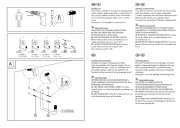
14 Juli 2025
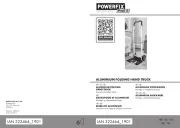
9 Juli 2025
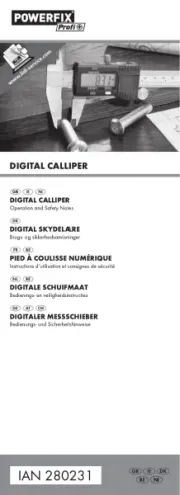
8 Juli 2025
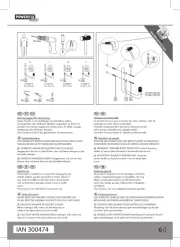
8 Juli 2025
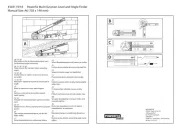
8 Juli 2025

16 November 2024

11 Juni 2023

8 Juni 2023

5 Juni 2023
Handleiding Niet gecategoriseerd
- Crofton
- Diamond Audio
- HTC
- J. Rockett Audio Designs
- Dyson
- Glide Gear
- Colonial Elegance
- Konig & Meyer
- Rome
- Jensen
- Hanseatic
- Dorr
- OLLO
- Fredenstein
- Grohe
Nieuwste handleidingen voor Niet gecategoriseerd
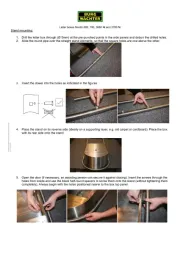
2 Augustus 2025
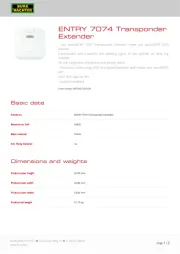
2 Augustus 2025
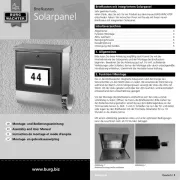
2 Augustus 2025
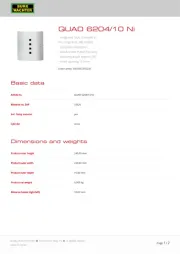
2 Augustus 2025
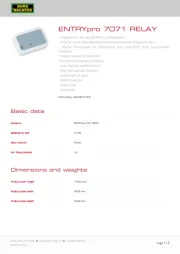
2 Augustus 2025
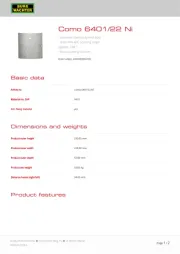
2 Augustus 2025
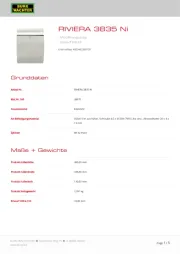
2 Augustus 2025
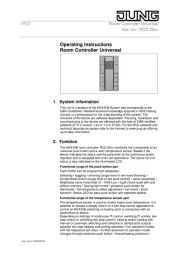
2 Augustus 2025
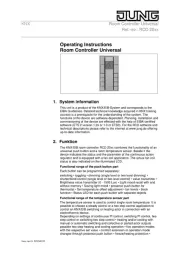
2 Augustus 2025
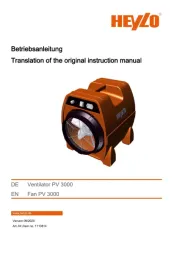
2 Augustus 2025